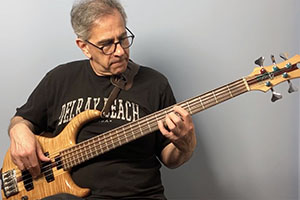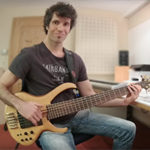The rationale behind choosing a low B or a high C
By Jon Liebman
Week of April 15, 2019
This week, we published an interview is with Mexican groover Pepe Hernández, whose boundless energy always inspires me. At the risk of arousing the ire of any 4-string purists, let me get this out right away: My takeaway from this interview has to do with the part where we talked about his NS Design 5-string bass. It wasn’t so much his choice of going from a 4 to a 5 that surprised me. Rather, it was his choice of a C string, instead of the generally expected low B, as the additional string.
Five- and six-string basses invariably evoke controversy, and often some pretty heated exchanges among bass players (see my blog about how many strings a bass “should” have here). And yes, we’ve all heard, repeatedly, that “Jaco only needed 4 strings.”
So what happens when a bass player opts for a high C string when making the transition from a 4 to a 5? Could that choice get a player into dangerous territory?
In most cases, the rationale behind adding a fifth string is to add more bottom to the bass, generally allowing a bassist to go down to a low B. In Pepe’s case, however, he chose the high C, which he says helps facilitate playing in position, avoiding unnecessary shifts up and down the fingerboard.
Since five-strings made their way into the mainstream of bass guitar collections, they’ve been widely used across many musical genres. Among those drawn to five-strings, at least some of the time, are rockers Stu Cook and Ricky Phillips, rock and R&B players Nathan East and Adam Nitti, Latin funksters Oskar Cartaya and John Peña, and many others. I can’t recall seeing any of those players opting for the high C over a low B, though.
Whichever string a player picks when expanding from 4 to 5 is okay with me, as long as the role of laying down the groove isn’t compromised and doesn’t give way to “too-high-for-a-bass” licks, fills, or what have you.
Pepe’s choice reminded me of a gig I had during my Florida years, where I used to play upright bass in a duo with a piano player in a swanky Coconut Grove hotel (can’t you just picture me in my tux, with my long, black hair?!). Unless I was soloing, whenever I went above, say, a D or an E on the G string, she would admonish me with, “Hey, cut it out! You’re a bass player. Get down where you belong!” Most of the time, I suppose she was right.
Have a thought on the subject? Leave a comment below, and let me know what you think. In the meantime, check out my interview with Pepe here.







When I switched from 4 string to 5 string, It was during the era, I’d say the 90’s and early 2000’s, when a lot of the music at that time, used synthesizers, to play the bass lines. So I went with the low B, because I wanted to be able to get down to those low notes, that those bass synth’s could get. oh, and I almost forgot…. At that time, it was a STATUS symbol!!! LOL You were look on in another light, if you pulled out a 5 or 6 string bass!!! As if people thought, he got a 5 or 6, he must can really play!!! LOLOLOL. But like they say, “it’s not how many strings you have, it’s what you can do with them”!!!
Steve Swallow plays a 5-string with a high C string. He solos a lot which is why I believe he made that choice.
Whether I use a 4 or 5 string bass Ian mostly dictated by the genre or genres to be played. For quite some time I almost exclusively played 5 string basses (both fretted and fretless) This had a natural explanation since both my main and best basses had 5 -strings. Both were tuned with a low B. I mainly had a supportive bass role and the low B felt natural.
Nowadays a play mainly 4-strings but occasionally I use the 5-strings if i feel that the low notes helps to express the music better.
I also want to play more chords, melodies and solos so now I have added a E-C tunes 5 string. But it’s not a regular long scale bass but a a custom Kala Solid Body super short scale (23,5 inch). It has nylon core round wound strings and gives me a perfect platform for the type of music I want to express with this tuning!
Switched to 5 for low B here in the 90’s but I also have a washtub bass that can play all the notes, one at a time.
To me it all depends on the situation. For example, I have worked with a lot of well known artists from all over the world such as Buika, Gloria Estefan, Daniela Mercury, Paul Stanley (from kiss) and many others. On this case, I would never take a 5 string high C to these gigs, simply because that wouldn’t support the artist or the music. So that’s a no go.
Now, on the other hand, I’m recording my new instrumental album which the bass takes most of the melodies, so on that particular case, there’s no problem at all having one of the instruments tuned with a high C and having a better melodic flow!
“Jaco only needed 4 strings.” Ok, but just what he could have done with 5 or 6. I have and use 4,5, and 6 string basses. I prefer the 6, but I work with some guys, ahem, that hate six strings for no good reason. I agree Jon, playing in position is a huge factor for me. On my six string, I detune the C string to B natural (BEADGB), for chords mostly. In Vanilla Fudge, I used a four for years until we recorded Spirit of ‘67. By the way I used all three on that album. Break on Through has a heavy metal passage with a low D and we play it live so I needed the low B. I’m using my five string now. I play locally in a guitar, bass, drums cover band trio. When the guitarist solos, I personally hate the absence of any chords, so I add them with my six string in that band. I can also hold down the bottom and add some orchestral parts too. Many people have come up to me and said, “You all sound like there’s more than three guys up there.” I attest that to my six string.
Finally, the range of a 24 fret six string bass (in standard tuning) is only 2-1/2 steps lower and 4 whole steps higher than a 21 fret four string bass. Why the fuss? I say, if the luthiers didn’t want us to use the upper frets, they wouldn’t have put them there. That goes for Leo, too.
“Those that don’t, can’t.” – Bubby Lewis.
… because they do take time to get used to. Hard for long time four players. I understand that. They did for me. But once you do…
I switched to 5 string, with the low B, in the mid 90’s when I started playing Gospel music, that had a lot of Synths and organs. I don’t even own a 4 string, anymore. I would only consider playing 4 string bass, if I played in a band with just guitars and no keyboards. I am one of those “position players”, so I like to have more notes under my fingers, especially since I prefer Stainless Steel round wound strings and try to lessen string noise that results from changing positions. When I solo (which is rare) my solos have a tendency to stay in lower registers. (My style choice) So a high C just wouldn’t work for me. No shade intended on the high C guys. I’m just not one of them.